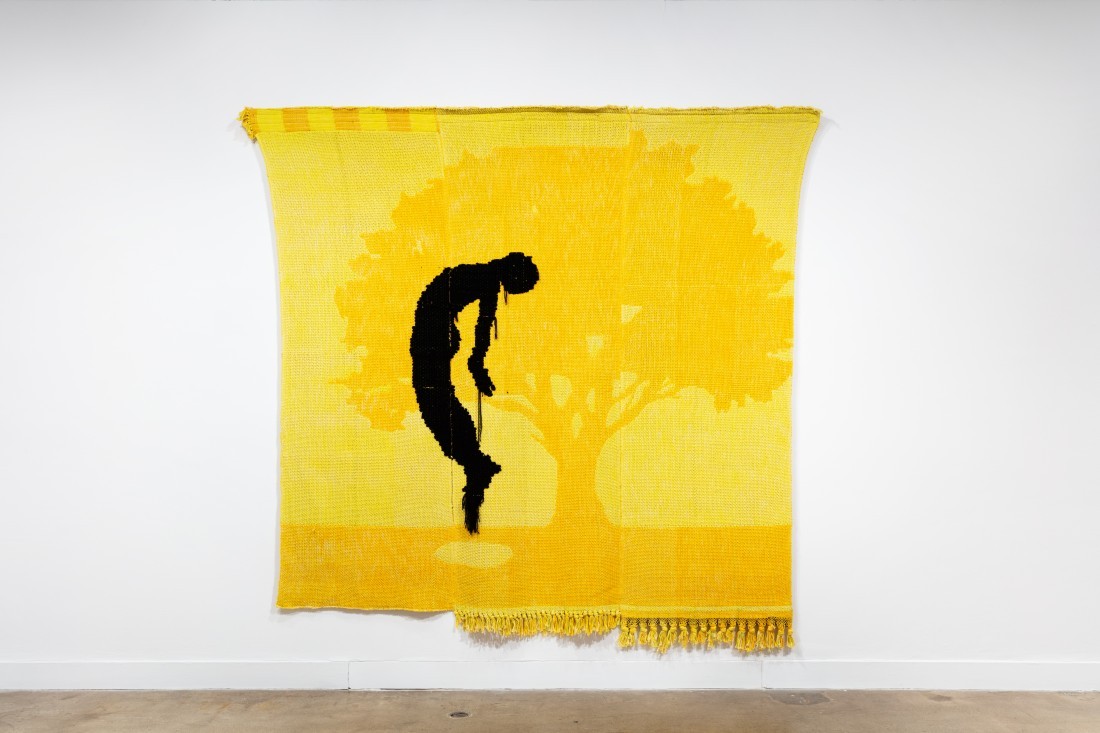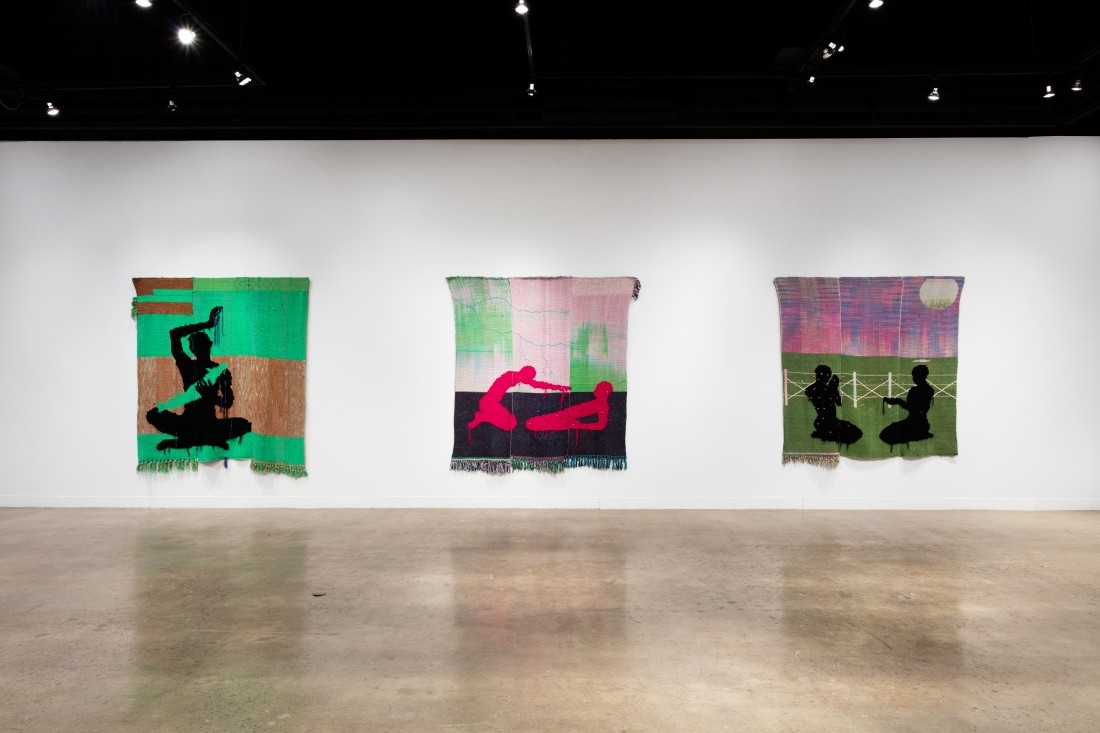Diedrick Brackens
“I‘ve inherited so many g h o s t s , ” Diedrick Brackens (b. Texas, 1989) explains in a recent interview with curator Legacy Russell. “There are all these people that I will never meet because of the virus, but I‘m always communing with them, trying to allow their voices to be made material.” The 32-yearold textile artist’s tapestries call openly on the words of queer poets, biblical allegory, Black American folklore, patterns from strip-woven Kente cloth, European narrative tapestries and the quilts of Gee’s Bend. With “shape of a fever believer,” seven tapestries woven in 2020 and displayed at Oakville Galleries this spring, Brackens specifically addresses not the COVID-19 virus but the 2016 CDC statistic, which states, “If current H.I.V. diagnoses rates persist, about 1 in 2 Black men who have sex with men (M.S.M.) and 1 in 4 Latino M.S.M. in the United States will be diagnosed with H.I.V. during their lifetime.” Brackens’s ghosts turn up as lifesized silhouettes, often in pairs, reaching out for, carrying and working to heal one another across highly saturated hand-dyed threads.
One voice returned to by the artist is the poet Essex Hemphill, who in 1992 wrote “American Wedding,” an ode to queer community and to the desire to thrive in the face of systemic erasure and illness: “They expect us to call in sick / watch television all night / die by our own hands. / They don’t know / we are becoming powerful. / Every time we kiss / we confirm the new world coming.” Hemphill died in 1995 of AIDS-related complications, just as antiretroviral drugs started to become widely available. His images of power in tenderness and interdependency are alive in Brackens’s work. Here, no one is watching TV all night. Sources of sustenance and survival take a multitude of forms—sometimes showing up as human touch, other times as a lightning bolt, a halo, a catfish, a pillbox. In cotton, the material chosen by Brackens for its ability to carry colour and Black American history, the artist conjures new rhythms of intimacy and joy in the face of ongoing precarity and death, which continue to disproportionally affect racialized bodies.

Diedrick Brackens, summer somewhere (for Danez), installation view, 2020, woven cotton and acrylic yarn. Photos: Laura Findlay. Photos courtesy Oakville Galleries.
lifesavers, 2020, the only nonfigurative piece in the show, hangs at the entrance to Oakville’s Centennial Square Gallery. Across its 90 x 84 inches of woven cotton and acrylic, a patchwork of circular cells stack together like LifeSavers hard candies, also like honeycomb or cells multiplying. A pillbox marking the days of the week firmly interrupts the cloth’s abstract pattern at the bottom. In a poem entitled “1 in 2,” the contemporary queer, non-binary and HIV-positive poet Danez Smith addresses the stark CDC statistic as well. “Queer bacteria has dotted my blood with snake mist,” Smith writes. At Oakville, in twin tapestries—entitled blessed are the mosquitoes, 2020, and shape of a fever believer, 2020—two figures face one another against open summer night landscapes, in the colours of Paul Klee’s Fire in the Evening, 1929. In conversation with Brackens last year, Smith described their poetry as propelled by a desire “to make the brain see what the naked eye cannot.” Snake mist is made visible in Brackens’s tapestries as buttons, loose stitches and small charms that dot and whir around his figures— signalling both viral spread and incandescence.
These marks call to mind the white, black and pink spots painted on the figure of Sonponnoi, 1987, the Yoruba god of smallpox, in a photograph by British-Nigerian photographer Rotimi Fani-Kayode. In Sonponnoi, a nude male holds a candle up to his naked frame—a shrine to the body in sickness. Fani- Kayode passed away in 1989 from AIDS-related illness. Brackens’s tapestries are as rich in history as they are patently new. Drawing on 1980s AIDS Coalition to Unleash Power (ACT UP) ▲ SILENCE=DEATH poster colours, black and pink recur across Brackens’s tapestries. In flying geese, 2020, two bodies woven in black thread accompany a third who is wholly neon pink. A pink hand melts into a black leg and a black arm glides through a pink chest. The thread embodying skin is porous, and the boundaries that separate each from each are criss-crossed. All three figures reach for a low-hanging moon in the sky above. The moon bends to their touch, as the divide between celestial and earthly bodies is softened.

Diedrick Brackens, “shape of a fever believer, installation view,” 2020, woven cotton and acrylic yarn.
In fire makes some dragons, 2020, hanging on the opposite side of the wall holding lifesavers, laid-brick columns rhyme with the pill boxes as Brackens plays again with the vocabulary of the woven grid. One man on fire lifts another from a building in flames. The brick, the fire and the tenderness of the gesture are reminiscent of Martin Wong’s Big Heat, 1988, the iconic painting in which two male firefighters kiss in front of a Lower East Side tenement tower. Emergency and fantasy collide in Brackens’s weavings much as they did in Wong’s paintings, intimating worlds where more is not just possible but beautiful. Across “shape of a fever believer,” bodies marked by disease or burning up in flames remain strong enough to offer one another aid and escape. The edges of these tapestries are kept loose and uneven. In this slack, Brackens leaves room for his ghosts to dance and for us to slip into their fray. ❚
“shape of a fever believer” was exhibited at Oakville Galleries, Oakville, ON, from January 10 to April 10, 2021.
Georgia Phillips-Amos is a British- American writer. She grew up in Málaga, Spain, and Long Island, New York, and has worked at Verso Books and New Directions.

